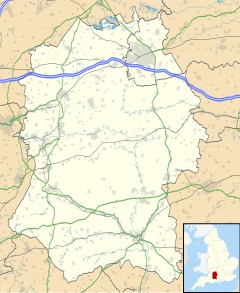Coombe Bissett is a village and civil parish in the English county of Wiltshire in the River Ebble valley, 3 miles (4.8 km) southwest of Salisbury on the A354 road that goes south towards Blandford Forum. The parish includes the village of Homington, to the east towards the village of Odstock.
| Coombe Bissett | |
|---|---|
 A354, Coombe Bissett | |
Location within Wiltshire | |
| Population | 675 (in 2011)[1] |
| OS grid reference | SU109264 |
| Civil parish |
|
| Unitary authority | |
| Ceremonial county | |
| Region | |
| Country | England |
| Sovereign state | United Kingdom |
| Post town | Salisbury |
| Postcode district | SP5 |
| Dialling code | 01722 |
| Police | Wiltshire |
| Fire | Dorset and Wiltshire |
| Ambulance | South Western |
| UK Parliament | |
| Website | www |
History
editRecords from Saxon times indicate that the Ebble valley was a thriving area, the River Ebble also being known as the River Chalke. The Domesday Book in 1086 divided the Chalke Valley into eight manors: Chelke (Chalke – Bowerchalke and Broadchalke), Eblesborne (Ebbesbourne Wake), Fifehide (Fifield Bavant), Cumbe (Coombe Bissett), Humitone (Homington), Odestoche (Odstock), Stradford (Stratford Tony and Bishopstone) and Trow (circa Alvediston).[2] The Domesday Book also recorded Cumbe as a royal manor with 85 households,[3] while Humitone had just two households.[4] A medieval packhorse bridge, now a footbridge, crosses the Ebble close to the current road bridge at Coombe Bissett.[5]
Coombe Bissett and Homington were separate parishes, each with its own church, until they were united in a joint benefice in 1885.[6] Homington was absorbed into Coombe Bissett civil parish in 1934.[7]
Religious sites
editThe two Anglican churches below are served by the Chalke Valley team ministry.[8]
St Michael's, Coombe Bissett
editThe oldest part of St Michael's, the south aisle, is from the 12th century. The chancel was built in the 13th and the tower (with stair-turret) added in the 14th; the nave and north transept are 15th-century. Restoration in 1845 by T.H. Wyatt included the rebuilding of the west front, reducing the length of the building.[9] The church is a Grade I listed building.[10]
St Mary's, Homington
editSt Mary's is a 14th-century church, possibly with earlier origins. The tower of the present church is from the early 17th century and there was extensive restoration in the 1860s. The church is a Grade II* listed building.[11]
Nonconformist chapels
editA Primitive Methodist chapel was built in 1841 at the west end of Homington village, then rebuilt in 1877. The chapel closed in 1967 and is now a private house.[12] In 1895 a Baptist chapel was opened at Coombe Bissett, on the road to Homington, and is used by the Coombe Fellowship.[13]
Amenities
editCoombe Bissett has a pub, the Fox and Goose, a village hall, and a shop with a post office. A primary school was built at Shutts Lane in the 1960s, replacing a small National School on the Homington road which was built in 1845.[14] Homington and Coombe Bissett Downs is a nature reserve on nearby chalk downland. There are various clubs within the village, including a tennis club, cricket club[15] and badminton club. Salisbury and South Wiltshire Golf Course is to the north of the village. Salisbury Hospital is to the east, north of Odstock village and a 10-minute drive from Coombe Bissett.
Notable people
edit- Tancred Borenius (1885–1948), Finnish art historian, died at Laverstock House hospital and is buried in Coombe Bissett churchyard.[16]
- Tim Smith (1961–2020), songwriter, composer and former leader of Cardiacs, spent his later years near Coombe Bissett.
Bordering areas
editReferences
edit- ^ "Coombe Bissett Census Information". Wiltshire Community History. Wiltshire Council. Retrieved 19 December 2014.
- ^ Ebbesbourne Wake through the Ages by Peter Meers
- ^ Coombe Bissett in the Domesday Book
- ^ Homington in the Domesday Book
- ^ Historic England. "Packhorse Bridge over River Ebble (1375630)". National Heritage List for England. Retrieved 30 April 2016.
- ^ "No. 25456". The London Gazette. 31 March 1885. pp. 1459–1460.
- ^ "Homington". A Vision of Britain through Time. University of Portsmouth. Retrieved 30 April 2016.
- ^ "Our Churches". Chalke Valley Church. Archived from the original on 27 March 2016. Retrieved 30 April 2016.
- ^ Pevsner, Nikolaus; Cherry, Bridget (revision) (1975) [1963]. Wiltshire. The Buildings of England (2nd ed.). Harmondsworth: Penguin Books. pp. 190–191. ISBN 0-14-0710-26-4.
- ^ Historic England. "Church of St Michael (1023802)". National Heritage List for England. Retrieved 1 May 2016.
- ^ Historic England. "Church of St Mary the Virgin (1023807)". National Heritage List for England. Retrieved 1 May 2016.
- ^ "Homington Primitive Methodist Chapel". Wiltshire Community History. Wiltshire Council. Retrieved 30 April 2016.
- ^ "Baptist Chapel, Coombe Bissett". Retrieved 30 April 2016.
- ^ "Coombe Bissett Church of England Primary School". Wiltshire Community History. Wiltshire Council. Retrieved 1 May 2016.
- ^ "Coombebissettcricketclub". sites.google.com.
- ^ John Harris; Richard Wilbourn (6 January 2014). Rudolf Hess: A New Technical Analysis of the Hess Flight, May 1941. History Press. p. 90. ISBN 978-0-7524-9565-1.
Carl Tancred Borenius (1885–1948) was born at Viipuri, Finland, modern Vyborg, Russia. He died at Coombe Bissett, near Salisbury in Wiltshire, UK.
External links
edit- Media related to Coombe Bissett at Wikimedia Commons
- Official website
- "Coombe Bissett". Wiltshire Community History. Wiltshire Council. Retrieved 30 April 2016.
- Acornley, Jennifer. "History of Coombe Bissett". www.coombebissett.com. Retrieved 30 April 2016.
- "History of St Michael and All Angels, Coombe Bissett". Chalke Valley Church. Archived from the original on 30 June 2016. Retrieved 1 May 2016.
- Acornley, Jennifer. "History of Homington". www.coombebissett.com. Retrieved 30 April 2016.
- "Homington Church History". Chalke Valley Church. Archived from the original on 30 June 2016. Retrieved 1 May 2016.
